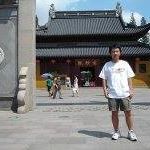Lin Xu
age ~53
from Fremont, CA
Lin Xu Phones & Addresses
- 216 Buck Ct, Fremont, CA 94539
- Katy, TX
- 4139 Bellaire Blvd, Houston, TX 77025 • 7135929469
- 7200 Almeda St, Houston, TX 77054 • 7137991359
- 7310 Staffordshire St, Houston, TX 77030 • 7137991359
- 2311 Chelsea Ridge Ct, Katy, TX 77450
Resumes

Lin Xu Stanford, CA
view sourceWork:
Boxer lab, Stanford University
Nov 2007 to 2000
Research Assistant Chemistry Department, Stanford University
Sep 2007 to Jun 2008
Teaching Assistant Peking University
Feb 2005 to Jul 2007
Research Assistant
Nov 2007 to 2000
Research Assistant Chemistry Department, Stanford University
Sep 2007 to Jun 2008
Teaching Assistant Peking University
Feb 2005 to Jul 2007
Research Assistant
Education:
Stanford University
Stanford, CA
Sep 2007 to 2012
Ph.D. in Chemistry Peking University
Sep 2003 to Jul 2007
B.S. in Chemistry
Stanford, CA
Sep 2007 to 2012
Ph.D. in Chemistry Peking University
Sep 2003 to Jul 2007
B.S. in Chemistry
Skills:
Protein expression, purification, and characterization; mutagenesis; organic synthesis; FTIR spectroscopy; X-ray crystallography; MD simulation and DFT calculation. Interpretation and presentation of data; optimization of workflow based on data; critical thinking. Experienced with FPLC, HPLC, NMR, MS, FTIR, UV-Vis. Familiar with Gromacs, MATLAB, Gaussian, PyMOL, VMD, and ChemDraw. Native Mandarin speaker.
Medicine Doctors

Lin Xu
view sourceSpecialties:
Psychiatry
Work:
Comcare Crisis Intervention Services
635 N Main St, Wichita, KS 67203
3166607525 (phone), 3166601897 (fax)
Comcare Of Sedrick County
1969 W 21 St N, Wichita, KS 67203
3166607750 (phone), 3166607851 (fax)
635 N Main St, Wichita, KS 67203
3166607525 (phone), 3166601897 (fax)
Comcare Of Sedrick County
1969 W 21 St N, Wichita, KS 67203
3166607750 (phone), 3166607851 (fax)
Education:
Medical School
Fujian Med Coll, Fuzhou City, Fujian, China
Graduated: 1983
Fujian Med Coll, Fuzhou City, Fujian, China
Graduated: 1983
Procedures:
Psychiatric Therapeutic Procedures
Conditions:
Anxiety Phobic Disorders
Bipolar Disorder
Depressive Disorders
Schizophrenia
Bipolar Disorder
Depressive Disorders
Schizophrenia
Languages:
English
Description:
Dr. Xu graduated from the Fujian Med Coll, Fuzhou City, Fujian, China in 1983. She works in Wichita, KS and 1 other location and specializes in Psychiatry. Dr. Xu is affiliated with Via Christi Hospital and Via Christi-Saint Joseph Campus.

Lin Xu
view sourceSpecialties:
Internal Medicine
Work:
Southshore Medical Associates
1 Bethany Rd STE 35, Hazlet, NJ 07730
7328881203 (phone)
1 Bethany Rd STE 35, Hazlet, NJ 07730
7328881203 (phone)
Education:
Medical School
Beijing Med Univ, Beijing City, Beijing, China
Graduated: 1982
Beijing Med Univ, Beijing City, Beijing, China
Graduated: 1982
Procedures:
Electrocardiogram (EKG or ECG)
Hearing Evaluation
Vaccine Administration
Hearing Evaluation
Vaccine Administration
Conditions:
Acne
Acute Bronchitis
Acute Conjunctivitis
Acute Sinusitis
Acute Upper Respiratory Tract Infections
Acute Bronchitis
Acute Conjunctivitis
Acute Sinusitis
Acute Upper Respiratory Tract Infections
Languages:
Chinese
English
English
Description:
Dr. Xu graduated from the Beijing Med Univ, Beijing City, Beijing, China in 1982. She works in Hazlet, NJ and specializes in Internal Medicine. Dr. Xu is affiliated with Bayshore Community Hospital.
Isbn (Books And Publications)

Zhongguo Ci Shan Shi Ye Fa Zhan Yan Jiu: A Study of the Development of Charity Undertakings in China
view sourceAuthor
Lin Xu
ISBN #
7508708288
Name / Title
Company / Classification
Phones & Addresses
Controller
Schlumberger Technology Corp
Geophysical Exploration
Geophysical Exploration
1325 S Dairy Ashford St, Houston, TX 77077
2812858500
2812858500
3189 SAYBROOK LLC
HEXICO INTERNATIONAL CULTURE & EDUCATION EXCHANGE LLC
President
VARIARTS
1021 Coleman Ave, Menlo Park, CA 94025
President
BEIJING MDT ELECTRONIC TECHNOLOGY DEVELOPMENT (S.F.) INC
125 Northwood Dr STE D, South San Francisco, CA 94080
Us Patents
-
Classification And Sequencing Of Mixed Data Flows
view source -
US Patent:7739267, Jun 15, 2010
-
Filed:Mar 10, 2006
-
Appl. No.:11/373084
-
Inventors:Qi Jin - San Jose CA, US
Dinkar Venkatraman Rao - San Jose CA, US
Sriram Srinivasan - Sunnyvale CA, US
Lin Xu - San Jose CA, US -
Assignee:International Business Machines Corporation - Armonk NY
-
International Classification:G06F 7/00
-
US Classification:707718, 707714, 707764
-
Abstract:A computer implemented method for processing a mixed data flow. Mixed data flow operators are classified. The mixed data flow operators are associated with multiple runtime environments in which the mixed data flow operators can be executed. The mixed data flow operators are segregated into regions. A mixed data flow operator in a particular region is executable by one of the multiple runtime environments associated with the particular region. The execution of the regions is sequenced.
-
Suppressor Of Hollow Cathode Discharge In A Shower Head Fluid Distribution System
view source -
US Patent:7744720, Jun 29, 2010
-
Filed:Dec 6, 2007
-
Appl. No.:11/951861
-
Inventors:Lee Chen - Cedar Creek TX, US
Lin Xu - Houston TX, US -
Assignee:Tokyo Electron Limited - Tokyo
-
International Classification:H01L 21/3065
C23C 16/455
C23C 16/505
B21K 21/08 -
US Classification:15634534, 15634533, 118715, 118723, 29890142
-
Abstract:A chamber component configured to be coupled to a process chamber and a method of fabricating the chamber component is described. The chamber component comprises a chamber element comprising a first surface on a supply side of the chamber element and a second surface on a process side of the chamber element, wherein the chamber element comprises a reentrant cavity formed in the first surface and a conduit having an inlet coupled to the reentrant cavity and an outlet coupled to the second surface. Furthermore, the chamber component comprises an insertable member configured to couple with the reentrant cavity, the insertable member having one or more passages formed there through and each of the one or more passages are aligned off-axis from the conduit, wherein the one or more passages are configured to receive a process fluid on the supply side and the conduit is configured to distribute the process fluid from the one or more passages on the process side.
-
System And Method For Data Model And Content Migration In Content Management Applications
view source -
US Patent:7774300, Aug 10, 2010
-
Filed:Dec 9, 2005
-
Appl. No.:11/299085
-
Inventors:Hui-I Hsiao - Saratoga CA, US
Joshua Wai-ho Hui - San Jose CA, US
Madhumati Krishnan - San Jose CA, US
Lin Xu - San Jose CA, US -
Assignee:International Business Machines Corporation - Armonk NY
-
International Classification:G09F 7/00
-
US Classification:707602
-
Abstract:A system and method for data model and content migration in content management applications is disclosed that facilitates data migration by utilizing a markup-language format to preserve dependency and enable compatibility among various platforms, applications, devices, etc. The method generally includes retrieving a plurality of objects, determining a dependency of the plurality of objects, extracting object definitions from the objects, forming a markup-language user document with the extracted object definitions utilizing the determined object dependency, and exporting the markup-language user document.
-
Two-Grid Ion Energy Analyzer And Methods Of Manufacturing And Operating
view source -
US Patent:7777179, Aug 17, 2010
-
Filed:Mar 31, 2008
-
Appl. No.:12/059983
-
Inventors:Lee Chen - Cedar Creek TX, US
Lin Xu - Houston TX, US
Ronald Victor Bravenec - Austin TX, US -
Assignee:Tokyo Electron Limited - Tokyo
-
International Classification:H01J 37/04
H01J 49/00
H01J 3/26 -
US Classification:250281, 250282, 250397, 324466
-
Abstract:An ion energy analyzer is described for use in diagnosing the ion energy distribution (IED) of ions incident on a radio frequency (RF) biased substrate immersed in plasma. The ion energy analyzer comprises an entrance grid exposed to the plasma, an electron rejection grid disposed proximate to the entrance grid, and an ion current collector disposed proximate to the electron rejection grid. The ion current collector is coupled to an ion selection voltage source configured to positively bias the ion current collector by an ion selection voltage, and the electron rejection grid is coupled to an electron rejection voltage source configured to negatively bias the electron rejection grid by an electron rejection voltage. Furthermore, an ion current meter is coupled to the ion current collector to measure the ion current.
-
Ion Energy Analyzer And Methods Of Manufacturing And Operating
view source -
US Patent:7875859, Jan 25, 2011
-
Filed:Mar 31, 2008
-
Appl. No.:12/059855
-
Inventors:Lee Chen - Cedar Creek TX, US
Lin Xu - Houston TX, US
Ronald Victor Bravenec - Austin TX, US -
Assignee:Tokyo Electron Limited - Tokyo
-
International Classification:G01K 1/08
-
US Classification:250397, 250396 R
-
Abstract:An ion energy analyzer is described for use in diagnosing the ion energy distribution (IED) of ions incident on a radio frequency (RF) biased substrate immersed in plasma. The ion energy analyzer comprises an entrance grid exposed to the plasma, an ion selection grid disposed proximate to the entrance grid, an electron rejection grid disposed proximate to the ion selection grid, and an ion current collector disposed proximate to the electron rejection grid. The ion selection grid is coupled to an ion selection voltage source configured to positively bias the ion selection grid by an ion selection voltage, and the electron rejection grid is coupled to an electron rejection voltage source configured to negatively bias the electron rejection grid by an electron rejection voltage. Furthermore, an ion current meter is coupled to the ion current collector to measure the ion current.
-
Method And Apparatus For Nano-Pantography
view source -
US Patent:7883839, Feb 8, 2011
-
Filed:Dec 4, 2006
-
Appl. No.:11/633233
-
Inventors:Vincent M Donnelly - Houston TX, US
Demetre J. Economou - Houston TX, US
Paul Ruchhoeft - Houston TX, US
Lin Xu - Houston TX, US
Sri Charan Vemula - Leuven, BE
Manish Kumar Jain - Houston TX, US -
Assignee:University of Houston - Houston TX
-
International Classification:G21K 1/08
C03C 25/60 -
US Classification:430323, 250396 R, 25049221, 250309, 25049222, 216 66, 216 67
-
Abstract:A method is provided for creating a plurality of substantially uniform nano-scale features in a substantially parallel manner in which an array of micro-lenses is positioned on a surface of a substrate, where each micro-lens includes a hole such that the bottom of the hole corresponds to a portion of the surface of the substrate. A flux of charged particles, e. g. , a beam of positive ions of a selected element, is applied to the micro-lens array. The flux of charged particles is focused at selected focal points on the substrate surface at the bottoms of the holes of the micro-lens array. The substrate is tilted at one or more selected angles to displace the locations of the focal points across the substrate surface. By depositing material or etching the surface of the substrate, several substantially uniform nanometer sized features may be rapidly created in each hole on the surface of the substrate in a substantially parallel manner.
-
System And Method For Nano-Pantography
view source -
US Patent:8030620, Oct 4, 2011
-
Filed:May 5, 2009
-
Appl. No.:12/435545
-
Inventors:Vincent M. Donnelly - Houston TX, US
Demetre J. Economou - Houston TX, US
Paul Ruchhoeft - Houston TX, US
Lin Xu - Houston TX, US
Sri Charan Vemula - Leuven, BE
Manish Kumar Jain - Houston TX, US -
Assignee:University of Houston - Houston TX
-
International Classification:H01J 3/26
G21K 1/08 -
US Classification:250396R, 25049221, 250309, 25049222, 216 66, 216 67, 430323, 118640
-
Abstract:A method is provided for creating a plurality of substantially uniform nano-scale features in a substantially parallel manner in which an array of micro-lenses is positioned on a surface of a substrate, where each micro-lens includes a hole such that the bottom of the hole corresponds to a portion of the surface of the substrate. A flux of charged particles, e. g. , a beam of positive ions of a selected element, is applied to the micro-lens array. The flux of charged particles is focused at selected focal points on the substrate surface at the bottoms of the holes of the micro-lens array. The substrate is tilted at one or more selected angles to displace the locations of the focal points across the substrate surface. By depositing material or etching the surface of the substrate, several substantially uniform nanometer sized features may be rapidly created in each hole on the surface of the substrate in a substantially parallel manner.
-
Method And Apparatus For Generating Code For An Extract, Transform, And Load (Etl) Data Flow
view source -
US Patent:8099725, Jan 17, 2012
-
Filed:Oct 11, 2006
-
Appl. No.:11/548659
-
Inventors:Qi Jin - San Jose CA, US
Hui Liao - Santa Clara CA, US
Lin Xu - San Jose CA, US -
Assignee:International Business Machines Corporation - Armonk NY
-
International Classification:G06F 9/44
G06F 9/45 -
US Classification:717151, 717106, 717153, 717154, 717159
-
Abstract:Methods, computer program products, and system for generating code for an extract, transform, and load (ETL) data flow are provided. In one implementation, the method includes receiving an ETL data flow representing a logical transformation and flow of data, placing a staging table at a pre-determined location in the ETL data flow to reduce a total number of staging tables required by the transformation, and generating code for the transformation based on the ETL data flow including the staging table placed at the pre-determined location.
Plaxo

lin xu
view source
Lin Xu
view sourceUnited Nations
Classmates

Seward Park High School, ...
view sourceGraduates:
lin xu (2006-2010),
Gloria Cortes (1971-1975),
Anna Keitt (1993-1997)
Gloria Cortes (1971-1975),
Anna Keitt (1993-1997)
Youtube
Myspace
Googleplus

Lin Xu
Lived:
San Jose, CA
Work:
Apple Inc - Senior application Specialist (2009)
Education:
San Jose State University - ESL
Relationship:
Married

Lin Xu
Work:
Lisheng
Education:
Tianjin University

Lin Xu

Lin Xu

Lin Xu

Lin Xu

Lin Xu

Lin Xu

Lin Xu Hg
view source
Cheril Lin Xu
view source
Lin Xu
view source
Lin Xu
view source
Carol Lin Xu
view source
Lin Xu
view source
Lin Xu
view source
Lin Xu
view sourceFlickr
Get Report for Lin Xu from Fremont, CA, age ~53
















